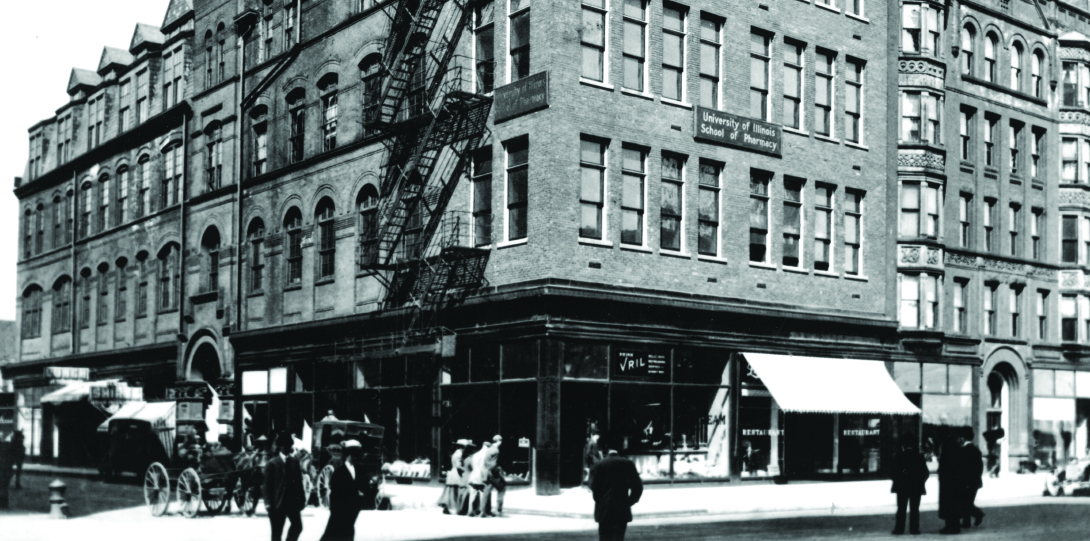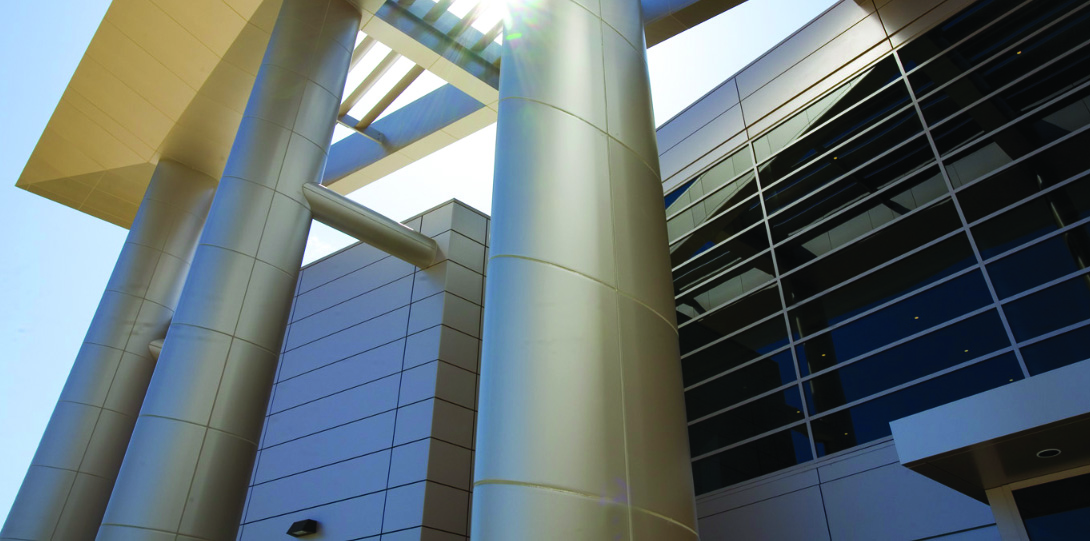Our History
TITLE Heading link
The University of Illinois Chicago College of Pharmacy has been known by many names and been in many locations in its storied history. But from its humble beginnings in rented halls in Downtown Chicago to its current spot as a world-renowned teaching and research institution with campuses in both Chicago and Rockford, Illinois, the institution has always been at the forefront of the ever-changing world of Pharmacy.
Founding Heading link
In 1852 the American Pharmaceutical Association (now known as the American Pharmacists Association) was created to advance the knowledge of pharmacy practitioners throughout the United States. Among their many lofty goals was crafting a formalized educational system for pharmacy practitioners who, at the time, were still called druggists. The next year a group of Chicago druggists formed a society to offer more formal means of training to supplement the apprenticeships that made up the bulk of the education of the day.
On September 12, 1859, the group finalized and notarized the charter and the Chicago College of Pharmacy, the precursor to the UIC College of Pharmacy, was born. The College had no official address at the time. The lectures were held in either the facilities of the lecturer or in halls rented just for the purpose of the lecture. Nonetheless, the College graduated its first class in 1861. The class consisted of 2 people.
The Great Chicago Fire Heading link
On the evening of October 8th, 1871 a fire alarm was pulled in a pharmacy on the south side of Chicago. A small fire had started around a small barn near the alley of 137 DeKoven Street. Between October 8thand the morning of October 10th, 1871, that “small fire” would consume over 3 square miles of the City of Chicago and later come to be known as “The Great Chicago Fire.”
The fire ravaged an astounding 20, 000 (mostly-wooden) buildings, including the College of Pharmacy. Having finally gotten a building to house them, the Chicago College of Pharmacy was once again homeless. Corresponding College Secretary Albert Ebert rallied support from alums and colleagues around the world to rebuild the college as well as restock its libraries and laboratories.
The college reopened in the fall of 1872 in the rebuilt Rice’s Building on Dearborn, between Washington and Randolph. The fall class was 37 students strong.
Laws Change, Names Change Heading link
In 1880 the College was instrumental in organizing the Illinois Pharmaceutical Association (now known as the Illinois Pharmacists Association or IPhA), a professional organization dedicated to, “enhancing the professional competency of pharmacists…and leading in the resolution of public policy issues affecting pharmacists.” One of the public policy issues facing pharmacists was education standards and government oversight. In 1881, the Illinois government passed the Pharmacy Law that mandated education requirements for pharmacy practice and assigned pharmacy oversight to state agencies. In addition to a $2 licensing fee, candidates also had to pass an examination by the State Board of Health.
The state legislature also amended the original charter for the University of Illinois in 1895. The change to the charter allowed the University to expand education outside of the boundaries of Champaign County where it is located. This presented the University with the opportunity to associate with and acquire educational bodies in other parts of the state. On May 1, 1896, the University of Illinois acquired the Chicago College of Pharmacy. After the acquisition, the name of the College of Pharmacy was officially changed to the University of Illinois School of Pharmacy.
A Guided Tour of South Wood Street Heading link
With the backing of the University of Illinois, the University of Illinois School of Pharmacy moved into Chicago’s West Side Medical District along with the colleges of medicine and dentistry in 1915. The University purchased two buildings for the School of Pharmacy: 701 and 707 S. Wood Street. This freedom would be somewhat undone in 1939 when the three colleges were moved under the same roof a little further south at the 808 S. Wood Street location. This all changed again in 1954 when the College of Pharmacy, now officially known as the University of Illinois College of Pharmacy, moved even further south to a newly constructed 6-story building at 833 S. Wood Street. That address is where the Chicago campus resides to this day.
The College of Pharmacy has grown right along with the Medical District. Now known as the Illinois Medical District, it includes 560 acres of medical research facilities, labs, a biotech business incubator, a raw development area, universities, and more than 40 healthcare-related facilities. This location offers great opportunities for collaboration, research, and service for both researchers and students alike.
Degrees Through The Years Heading link
The educational offerings of the College of Pharmacy have changed dramatically over the years in order to advance the practice of Pharmacy. The original coursework consisted of a 4-year apprenticeship and 20 weeks of evening lectures. When the Illinois Pharmacy Law of 1881 created a licensing board and government oversight the College created the Graduate of Pharmacy (PhG) program. Only PhG graduates could qualify for registration as pharmacists in Illinois. In 1884 a three-year course of study was created for pharmaceutical chemists. In 1932 a four-year course was introduced with one year of college education and a three-year professional program. 1960 saw the arrival of the 5 year Bachelor of Science degree, and in 1984 the Doctor of Pharmacy Degree was introduced as the only professional degree awarded.
One College, Two Campuses Heading link
In 2010 the College expanded once again in both location and degree offerings by building a campus in Rockford, Illinois. Located a mere 90 miles from Chicago, the town of Rockford hosts the Rural Pharmacy Program (RPHARM) in 30,000 square feet of new construction. They also renovated and remodeled an additional 20,000 square feet of space. Students at the Rockford campus receive the same great education as students in Chicago thanks to state-of-the-art connected classrooms.
The Future Heading link
The University of Illinois Chicago College of Pharmacy is a unique place filled with a rich history, but not stuck in the past. The College continues to refine and innovate, leading the Pharmacy world in both education and research. With that foundation to build on, there is no limit to what the College can accomplish in the future.


